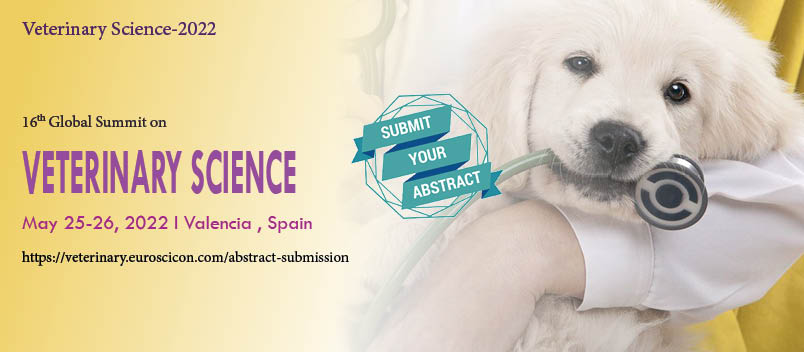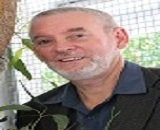VETERINARY SCIENCE 2022
ABOUT CONFERENCE
ABOUT CONFERENCE
Importance & Scope
International Conference on Veterinary Medicine and Animal Health focused on learning about Animal Health/ Veterinary Medicine and its advances; this is your best opportunity to reach best veterinarians, veterinary technicians and the largest assemblage of participants from the Veterinary Community. Our Veterinary Conference planned keeping in mind with best scientific sessions, exhibitions, poster presentations, oral presentations, workshops, symposiums, luncheons, and great keynotes.
World-renowned speakers, the most recent techniques, developments and the newest updates in Animal Health, and Veterinary are hallmarks of our conference.
Throughout the ages humans have depended on animals for service, food, and companionship. In modern times, animals have even played a crucial role in research settings where diseases are studied and drug therapies are developed. Veterinary medicine and animal care focus on the provision of health care, surgery, and preventive services for a variety of animal species. Veterinarians and veterinary technicians address health emergencies as well as provide routine medical care.
This veterinary conference focuses on the exponential growth taking place in the veterinary sector. Veterinary medicine has responsibilities in biomedical research; ecosystem management; public health; food and agricultural systems; and care of companion animals, wildlife, exotic animals and food animals. The veterinary profession contributes to improvement of human and public health by improving agriculture and food systems, advancing biomedical and comparative medical research, preventing and addressing zoonotic diseases, enhancing environmental and ecosystem health and helping manage 21st century public health challenges.
Who Can Attend the Conference?
- Veterinarians
- Veterinary Technicians
- Veterinary Clinic Teams
- Researchers and Specialists
- Veterinary Faculty
- Veterinary Medicine Faculty
- Animal Sciences Faculty
- Veterinary Students
- Animal Science Students
- Veterinary Nurse
- Veterinary Groups
- Veterinary Societies
- Veterinary Associations
- Animal Health Companies
Reasons to Attend Euro Veterinary-2022:
- Grow Your Professional Network
- Meet Experts & Influencers in Your Field
- Live Interaction with Like Minded People
- Share Your Content
- Learn New Things
- Grow Your Self
- Conference CE/ CPD
- Continuing Education
- Global Reach & Highest Visibility
- Workshops, Symposiums and Exhibitions
- Have Fun
Previous Year Veterinary Conference Statistics:
- 83% of attendees were core people from veterinary medicine
- 62% of attendees were Professor/Researcher/President/Policy Officer/Chief Representative
- 21% are Students/Specialist/Post Doc
- 12% Delegate/Company Representative/Consultant/Economist
- 5% Manager/Head/Director
What People are saying about our Annual Veterinary Meeting?
- 95% Said they would recommend this Congress to a colleague or others
- 91% said this veterinary event was equal or better compared with other events attended
- 96% said this veterinary congress met or exceeded their expectations
SESSIONS AND TRACKS
Track1: Veterinary Research
Veterinary science is important to the study of livestock, herd health and monitoring the spread of disease. It requires the application of scientific knowledge in multiple areas and the use of technical skills in disease prevention that may affect both pets and wild animals. Animal Production facilitates improvements in agricultural productivity, with emphasis on animal production systems and administers the animal improvement. Animal production sector has been undergoing change at a remarkable pace over the past few decades. Research in Veterinary Science is an International multi-disciplinary communications of a high scientific and ethical standard in all aspects of veterinary and biomedical research.
Session Keywords:
- Veterinary Workshops
- Animal congress, Animal Research
- Conference on Veterinary
- Veterinary symposia
- Animal science symposia
- Animal science
- Animal science Conference
- Animal science Meeting
- Animal science Events
- Conference on Animal Sciences
- Meat Science
- Animal diagnostics
- Species conservation
- Animal science Workshops
Track2: Veterinary Medicine
Veterinary medicine is the branch of medicine that deals with the prevention, diagnosis and treatment of disease, disorder and injury in non-human animals. The scope of veterinary medicine is wide, covering all animal species, both domesticated and wild, with a wide range of conditions which can affect different species.
Veterinary medicine is widely practiced, both with and without professional supervision. Professional care is most often led by a veterinary physician (also known as a vet, veterinary surgeon or veterinarian), but also by paraveterinary workers such as veterinary nurses or technicians. This can be augmented by other paraprofessionals with specific specialisms such as animal physiotherapy or dentistry, and species relevant roles such as farriers.
Session Keywords:
- Animal Research
- Veterinary Workshops
- Conference on Veterinary
- Veterinary symposia
- Animal science symposia
- Animal science
- Animal science Conference
- Animal science Meeting
- Animal science Events
- Conference on Animal Sciences
- Animal science Workshops
- Meat Science
- Species conservation
- Animal diagnostics
Track3: One Health
'One Health' is an approach to designing and implementing programs, policies, legislation and research in which multiple sectors communicate and work together to achieve better public health outcomes.
The areas of work in which a One Health approach is particularly relevant include food safety, the control of zoonoses (diseases that can spread between animals and humans, such as flu, rabies and Rift Valley Fever), and combatting antibiotic resistance (when bacteria change after being exposed to antibiotics and become more difficult to treat).
Session Keywords:
- Veterinary symposia
- Animal Research
- Veterinary Workshops
- Conference on Veterinary
- Animal science symposia
- Animal science
- Animal science Conference
- Animal science Meeting
- Animal science Events
- Conference on Animal Sciences
- Species conservation
- Animal diagnostics
- Animal science Workshops
- Meat Science
Track4: Animal nutrition
Animal nutrition focuses on the dietary needs of animals, primarily those in agriculture and food production, but also in zoos, aquariums, and wildlife management. There are seven major classes of nutrients: carbohydrates, fats, fiber, minerals, proteins, vitamins, and water.Animal nourishment concentrates on the dietary needs of domesticated animals, principally those in horticulture and food production. There are seven noteworthy classes of supplements: sugars, fats, fiber, minerals, protein, vitamin, and water. Most foods contain a blend of a few or the greater part of the supplement classes, together with different substances, for example, toxins or different sorts. A few supplements can be stored internally (e.g., the fat solvent vitamins), while others are required pretty much persistently. Weakness can be caused by an absence of required supplements or, in extraordinary cases, a lot of a required supplement.
Session Keywords:
- Meat Science
- Food Security
- Species conservation
- Veterinary symposia
- Animal Research
- Veterinary Workshops
- Conference on Veterinary
- Animal science symposia
- Animal science
- Animal science Conference
- Animal science Meeting
- Animal science Events
- Conference on Animal Sciences
- Animal diagnostics
- Meat Science
- Animal science Workshops
Track 5: Veterinary chiropractic
Veterinary chiropractic, also known as animal chiropractic, is the practice of spinal manipulation or manual therapy for animals. Veterinary chiropractors typically treat horses, racing greyhounds, and pets. It has become a fast developing field in animal alternative medicine. It remains controversial within certain segments of the veterinary and chiropractic profession. There is some degree of risk associated with even skilled manipulation in animals as the potential for injury exists with any technique used. Veterinary chiropractors typically treat horses, racing greyhounds, and pets. Some animal chiropractors perform adjusts on exotic animals such as birds, dolphins elephants, iguanas, turkeys, pigs, and llamas. It has become a fast developing area. A 2011 survey in New Zealand found that use of animal chiropractic on competition race horses is widespread.
Session Keywords:
- Species conservation
- Veterinary symposia
- Animal Research
- Veterinary Workshops
- Conference on Veterinary
- Animal science symposia
- Animal science
- Animal science Conference
- Animal science Meeting
- Animal science Events
- Conference on Animal Sciences
- Animal diagnostics
Track 6: Livestock & Nutrition
Precision livestock farming is a tool that imparts continuous automated real-time data to help monitor and manage livestock production and ameliorate individual animal or overall performance. Many years of innovation and early adoption of new technologies has enhanced their success. The pace of change and range of opportunities are unlikely to diminish in the future and we surmise it is vital for all farmers to keep in touch with innovations and understand how they can be applied to their farming businesses to improve their management and physical and financial performance.
Session Keywords:
- Animal Research
- Veterinary Workshops
- Conference on Veterinary
- Veterinary symposia
- Animal science symposia
- Animal science
- Animal science Conference
- Animal science Meeting
- Animal science Events
- Conference on Animal Sciences
- Animal science Workshops
- Meat Science
- Species conservation
- Animal diagnostics
Track 7: Animal Ethology
Ethology is the scientific and objective study of animal behavior, usually with a focus on behavior under natural conditions, and viewing behavior as an evolutionarily adaptive trait. Behaviourism is a term that also describes the scientific and objective study of animal behavior, usually referring to measured responses to stimuli or trained behavioral responses in a laboratory context, without a particular emphasis on evolutionary adaptivity. Ethology is a rapidly growing field. Since the dawn of the 21st century, many aspects of animal communication, emotions, culture, learning and sexuality that the scientific community long thought it understood have been re-examined, and new conclusions reached. New fields, such as neuroethology, have developed.
Understanding ethology or animal behavior can be important in animal training. Considering the natural behaviors of different species or breeds enables the trainer to select the individuals best suited to perform the required task. It also enables the trainer to encourage the performance of naturally occurring behavior’s and also the discontinuance of undesirable behaviors
Session Keywords:
- Species conservation
- Veterinary symposia
- Animal Research
- Veterinary Workshops
- Conference on Veterinary
- Animal science symposia
- Animal science
- Animal science Conference
- Animal science Meeting
- Animal science Events
- Conference on Animal Sciences
- Animal diagnostics
- Meat Science
Track 8: Regulatory Aspects of Animal Science
The protection and welfare of animals is an area covered by a wide range of legislation. This includes the protection of wildlife, zoo animals, farm animals, animals in transport and animals used for scientific purposes. Animal studies, whether for the development or production of new medicines, for physiological studies, for studying environmental effects or for the testing of chemicals or new food additives, has to be carried out in compliance with legislation.
Session Keywords:
- Meat Science
- Food Security
- Species conservation
- Veterinary symposia
- Animal Research
- Veterinary Workshops
- Conference on Veterinary
- Animal science symposia
- Animal science
- Animal science Conference
- Animal science Meeting
- Animal science Events
- Conference on Animal Sciences
- Animal diagnostics
- Meat Science
Track 9: Animal Welfare
Animal welfare is the prosperity of creatures. The models of good animal welfare change significantly between various contexts. These norms are under steady audit and are discussed, made and reexamined by animal welfare groups, lawmakers and scholastics worldwide. Animal welfare science utilizes different measures, for example, life span, sickness, immunosuppression, conduct, physiology, and reproduction, although there is debate about which of these markers give the best information. Concern to animal welfare is frequently in light of the conviction that non-human creatures are aware and that thought ought to be given to their prosperity or enduring, particularly when they are under the care of people.
Session Keywords:
- Meat Science
- Food Security
- Species conservation
- Veterinary symposia
- Animal Research
- Veterinary Workshops 2018
- Veterinary Workshops
- Conference on Veterinary
- Animal science symposia
- Animal science
- Animal science Conference
- Animal science Meeting
- Animal science Events
- Conference on Animal Sciences
- Animal diagnostics
- Meat Science
- Animal science Workshops
Track10: Veterinary Toxicology
Veterinary toxicology has grown into a multifaceted discipline that utilizes many diverse sources of toxicological information. Veterinary toxicologists can be involved in basic toxicology research, clinical toxicology, regulatory toxicology, chemical risk assessment and chemical food safety in private, academic, clinical, government, and commercial settings, among others. Like many areas of science, veterinary toxicology information is being generated at rates much higher than most professionals can access it and incorporate its principles into practice. Veterinary toxicologists need access to a wide variety of information sources to remain abreast of current toxicological information and to make sound clinical choices. The internet has provided the veterinary toxicologist with a valuable tool to access both historical and cutting-edge research information in a timely and cost-effective manner.
Session Keywords:
- Veterinary Workshops 2018
- Animal Research
- Veterinary Workshops
- Conference on Veterinary
- Veterinary symposia
- Animal science symposia
- Animal science
- Animal science Conference
- Animal science Meeting
- Animal science Events
- Conference on Animal Sciences
- Animal science Workshops
- Meat Science
- Species conservation
- Animal diagnostics
Track11: Veterinary Dentistry
Veterinary dentistry is the field of dentistry applied to the care of animals. It is the art and science of prevention, diagnosis, and treatment of conditions, diseases, and disorders of the oral cavity, the maxillo-facial region, and its associated structures as it relates to animals.
Session Keywords:
- Veterinary symposia
- Animal Research
- Veterinary Workshops 2018
- Veterinary Workshops
- Conference on Veterinary
- Animal science symposia
- Animal science
- Animal science Conference
- Animal science Meeting
- Animal science Events
- Conference on Animal Sciences
- Species conservation
- Animal diagnostics
- Animal science Workshops
- Meat Science
Track12: Veterinary Forensics
Veterinary Forensic Sciences is the convergence of a broad spectrum of sciences, including veterinary medicine, to provide answer to the questions of interest at a court of law related to animal abuse. It can be used to solve the animal related crime. Veterinary forensics is a continuous growing field that holds vast opportunities for research. As the field becomes more prominent, new areas of specialization will open up; giving investigators the chance to become specialists in one specific aspect of veterinary forensics and each of these will provide research opportunities. The melding of human and veterinary forensics will subsequently benefit society, protecting people and animals alike.
Session Keywords:
- Meat Science
- Food Security
- Species conservation
- Veterinary symposia
- Animal Research
- Veterinary Workshops 2018
- Veterinary Workshops
- Conference on Veterinary
- Animal science symposia
- Animal science
- Animal science Conference
- Animal science Meeting
- Animal science Events
- Conference on Animal Sciences
- Animal diagnostics
- Meat Science
- Animal science Workshops
Track13: Animal Diseases
Animal Disease an impairment of the normal state of an animal that interrupts or modifies its vital functions. Concern with diseases that afflict animals dates from the earliest human contacts with animals and is reflected in early views of religion and magic. Diseases of animals remain a concern principally because of the economic losses they cause and the possible transmission of the causative agents to humans.
Session Keywords:
- Species conservation
- Veterinary symposia
- Animal Research
- Veterinary Workshops 2018
- Veterinary Workshops
- Conference on Veterinary
- Animal science symposia
- Animal science
- Animal science Conference
- Animal science Meeting
- Animal science Events
- Conference on Animal Sciences
- Animal diagnostics
- Meat Science
Track14: Poultry Farming & Management
Poultry farming is the process of raising domesticated birds such as chickens, ducks, turkeys and geese for the purpose of farming meat or eggs for food. Poultry - mostly chickens - are farmed in great numbers. Farmers raise more than 50 billion chickens annually as a source of food, both for their meat and for their eggs. Chickens raised for eggs are usually called layers while chickens raised for meat are often called broilers.
Session Keywords:
- Meat Science
- Food Security
- Species conservation
- Veterinary symposia
- Animal Research
- Veterinary Workshops 2018
- Veterinary Workshops
- Conference on Veterinary
- Animal science symposia
- Animal science
- Animal science Conference
- Animal science Meeting
- Animal science Events
- Conference on Animal Sciences
- Animal diagnostics
- Meat Science
Track15: Veterinary Care & Management
Veterinary care is a representative piece of animal care and utilizes Program. The essential concentration of the veterinarian is to focus on the prosperity and clinical care of animals. Utilized as a part of research, testing, educating, and production. This duty agrees of observing and the advancement of animal prosperity constantly amid all periods of the life of animals.
Session Keywords:
- Veterinary symposia
- Animal Research
- Veterinary Workshops 2018
- Veterinary Workshops
- Conference on Veterinary
- Animal science symposia
- Animal science
- Animal science Conference
- Animal science Meeting
- Animal science Events
- Conference on Animal Sciences
- Species conservation
- Animal diagnostics
- Animal science Workshops
- Meat Science
Track16: Veterinary Epidemiology
Veterinary epidemiology is a key component in a number of the global grand challenges relating to disease control, food security and climate change. Consequently, there is a need to improve our ability to understand, predict and respond to patterns and dynamics of disease and to control outbreaks.
Session Keywords:
- Veterinary Workshops 2018
- Animal Research
- Veterinary Workshops
- Conference on Veterinary
- Veterinary symposia
- Animal science symposia
- Animal science
- Animal science Conference
- Animal science Meeting
- Animal science Events
- Conference on Animal Sciences
- Animal science Workshops
- Meat Science
- Species conservation
- Animal diagnostics
Track17: Camel and Equine Science
Camel thought to have been first trained by local individuals over 5,000 years prior, these solid creatures have demonstrated imperative to the survival of people in these regions as they are not simply utilized for transporting the two individuals and merchandise, yet additionally give a decent wellspring of drain, meat and fleece. The Camel is a standout amongst the most special warm-blooded creatures on the planet and has adjusted superbly to life in the desert where sustenance and water can frequently be rare and the temperature changes quickly from the searing hot days to the cooler evenings. Be that as it may, in spite of the fact that they would have once been discovered openly wandering the Arabian deserts, they are today wiped out from the wild however the household populace is across the board and various. Veterinary meeting welcoming dynamic on propels in camel science.
Session Keywords:
- Veterinary Workshops 2018
- Animal Research
- Veterinary Workshops
- Conference on Veterinary
- Veterinary symposia
- Animal science symposia
- Animal science
- Animal science Conference
- Animal science Meeting
- Animal science Events
- Conference on Animal Sciences
- Animal science Workshops
- Meat Science
- Species conservation
- Animal diagnostics
Track18: Animal Reproduction and Genetics
Animal Reproduction and Geneticshttps://veterinary.euroscicon.com/ describes how animals compete with other individuals to maintain themselves for a period of time that would be sufficient to enable them to produce tissue that would be indispensable to the maintenance of their species. Animal genetics impart advance breeding technology and testing services such as genetic trait tests, DNA typing and genetic disease tests and Animal genetics is a branch of genetics that studies heredity and variation chiefly in farm animals but also in domestic and wild animals. It is based on general genetic principles and concepts, and it mainly uses the hybrid, cytological, population, ontogenetic, mathematical-statistical and twin methods of general genetics.
Session Keywords:
- Meat Science
- Food Security
- Species conservation
- Veterinary symposia
- Animal Research
- Veterinary Workshops 2018
- Veterinary Workshops
- Conference on Veterinary
- Animal science symposia
- Animal science
- Animal science Conference
- Animal science Meeting
- Animal science Events
- Conference on Animal Sciences
- Animal diagnostics
- Meat Science
Track19: Veterinary Microbiology and Microbial Disease
Veterinary Microbiology is concerned with microbial (bacterial, fungal, viral) diseases of domesticated vertebrate animals (livestock, companion animals, fur-bearing animals, game, poultry, but excluding fish) that supply food, other useful products or companionship. In addition, Microbial diseases of wild animals living in captivity, or as members of the feral fauna will also be considered if the infections are of interest because of their interrelation with humans (zoonosis) and/or domestic animals. Studies of antimicrobial resistance are also included, provided that the results represent a substantial advance in knowledge.
Session Keywords:
- Veterinary symposia
- Animal Research
- Veterinary Workshops 2018
- Veterinary Workshops
- Conference on Veterinary
- Animal science symposia
- Animal science
- Animal science Conference
- Animal science Meeting
- Animal science Events
- Conference on Animal Sciences
- Species conservation
- Animal diagnostics
- Animal science Workshops
- Meat Science
Track20: Zoonosis
Zoonoses are infectious diseases that can be naturally transmitted between animals (usually vertebrates) and humans. Major modern diseases such as Ebola virus disease and salmonellosis are zoonosis. HIV was a zoonotic disease transmitted to humans in the early part of the 20th century, though it has now evolved to a separate human-only disease. Most strains of influenza that infect humans are human diseases, although many strains of swine and bird flu are zoonosis; these viruses occasionally recombine with human strains of the flu and can cause pandemics such as the 1918 Spanish flu or the 2009 swine flu. Taenia solium infection is one of the neglected tropical diseases with public health and veterinary concern in endemic regions. Zoonosis can be caused by a range of disease pathogens such as viruses, bacteria, fungi and parasites; of 1,415 pathogens known to infect humans, 61% were zoonotic. Most human diseases originated in animals; however, only diseases that routinely involve animal to human transmission, like rabies, are considered direct zoonosis.
Zoonosis have different modes of transmission. In direct zoonosis the disease is directly transmitted from animals to humans through media such as air (influenza) or through bites and saliva (rabies). In contrast, transmission can also occur via an intermediate species (referred to as a vector), which carry the disease pathogen without getting infected. When humans infect animals, it is called reverse zoonosis or anthroponosis
Session Keywords:
- Veterinary Workshops 2018
- Animal Research
- Veterinary Workshops
- Conference on Veterinary
- Veterinary symposia
- Animal science symposia
- Animal science
- Animal science Conference
- Animal science Meeting
- Animal science Events
- Conference on Animal Sciences
- Animal science Workshops
- Meat Science
- Species conservation
- Animal diagnostics
Track21: Dairy farming
Dairy farming is a class of agriculture for long-term production of milk, which is processed (either on the farm or at a dairy plant, either of which may be called a dairy) for eventual sale of a dairy product.
Centralized dairy farming as we understand it primarily developed around villages and cities, where residents were unable to have cows of their own due to a lack of grazing land. Near the town, farmers could make some extra money on the side by having additional animals and selling the milk in town. The dairy farmers would fill barrels with milk in the morning and bring it to market on a wagon. Until the late 19th century, the milking of the cow was done by hand. In the United States, several large dairy operations existed in some northeastern states and in the west that involved as many as several hundred cows, but an individual milker could not be expected to milk more than a dozen cows a day. Smaller operations predominated.
Session Keywords:
- Species conservation
- Veterinary symposia
- Animal Research
- Veterinary Workshops 2018
- Veterinary Workshops
- Conference on Veterinary
- Animal science symposia
- Animal science
- Animal science Conference
- Animal science Meeting
- Animal science Events
- Conference on Animal Sciences
- Animal diagnostics
- Meat Science
Track22: Animal Hematology
Hematology, also spelled haematology, is the branch of medicine concerned with the study of the cause, prognosis, treatment, and prevention of diseases related to blood. It involves treating diseases that affect the production of blood and its components, such as blood cells, hemoglobin, blood proteins, bone marrow, platelets, blood vessels, spleen, and the mechanism of coagulation. Such diseases might include hemophilia, blood clots, other bleeding disorders and blood cancers such as leukemia, multiple myeloma, and lymphoma. The laboratory work that goes into the study of blood is frequently performed by a medical technologist or medical laboratory scientist. Many hematologists work as hematologist-oncologists, also providing medical treatment for all types of cancer.
Session Keywords:
- Species conservation
- Veterinary symposia
- Animal Research
- Veterinary Workshops 2018
- Veterinary Workshops
- Conference on Veterinary
- Animal science symposia
- Animal science
- Animal science Conference
- Animal science Meeting
- Animal science Events
- Conference on Animal Sciences
- Animal diagnostics
- Meat Science
Track23: Animal Rehabilitation
Wildlife rehabilitation is the treatment and care of injured, orphaned, or sick wild animals so that they can be released back to the wild.
Rehabilitation begins when an animal is found and reported to a wildlife rehabilitator, or seized from the illegal wildlife trade or a poacher. The rehabilitator will examine the animal to determine the extent of the injury and the probability of successful rehabilitation. If it appears that the animal can make a sufficient recovery to be able to return to the wild, the animal will be fed, nurtured, provided safe temporary housing, and medically treated as necessary.
Animals that cannot be rehabilitated are usually euthanized humanely, although animals are occasionally placed at facilities appropriately licensed for educational exhibit or brought into appropriate lifetime care in a wildlife rescue center.
A non-releasable animal may sometimes be kept by the rehabilitator (under separate permit) as a surrogate parent for orphaned or injured young wildlife.
Session Keywords:
- Meat Science
- Food Security
- Species conservation
- Veterinary symposia
- Animal Research
- Veterinary Workshops 2018
- Veterinary Workshops
- Conference on Veterinary
- Animal science symposia
- Animal science
- Animal science Conference
- Animal science Meeting
- Animal science Events
- Conference on Animal Sciences
- Animal diagnostic
Track24: Animal Breeding
Animal breeding is a branch of animal science that addresses the evaluation (using best linear unbiased prediction and other methods) of the genetic value (estimated breeding value, EBV) of livestock. Selecting for breeding animals with superior EBV in growth rate, egg, meat, milk, or wool production, or with other desirable traits has revolutionized livestock production throughout the world.
Session Keywords:
- Veterinary Workshops 2018
- Animal Research
- Veterinary Workshops
- Conference on Veterinary
- Veterinary symposia
- Animal science symposia
- Animal science
- Animal science Conference
- Animal science Meeting
- Animal science Events
- Conference on Animal Sciences
- Animal science Workshops
- Meat Science
- Species conservation
- Animal diagnostics
Market Analysis
Veterinary field is one of the fastest growing in the United States. Demand for new treatments such as hip replacements, blood transfusions and cancer treatments are helping to drive the increase. While the veterinary care industry is growing, it’s the technician and technologist positions that are projected to have the largest increase in the next two years. Job growth for veterinary technologists and technicians is expected to increase by 41% in 2016. The US Bureau of Labor Statistics says this is because pet owners are becoming more affluent while the number of pets continues to grow, so technologists and technicians able to provide specialized services will continue to be in demand. Veterinarian job growth is expected to increase 27.6% in 2016.
Projections:
The veterinary education market is at or very near equilibrium. The outlook for both the near and long term is improving for the veterinary profession, as the recession that began in December of 2007 continues to fade and the U.S. economy begins to return to the longer-term growth trend. Better information on veterinary markets will enhance the profession’s ability to develop strategies to improve the efficiency of the markets and assist in attempts to reach desired market outcomes. Modern veterinary research has markedly improved the quality of life of animals and humans, as indicated by numerous historical achievements. The demands on veterinary research have not diminished but rather have increased, with such emerging threats as bioterrorism and emerging infectious diseases. Veterinary and comparative medicine research is becoming a more pressing need than ever before. The ability of veterinary researchers to address the threats of animal disease and to meet societal needs depends largely on the nation's research capacity. Because research resources are finite, it is important to set a research agenda that will address high-priority issues and anticipate future needs and that can be executed effectively.
The ability to provide veterinary services begins in the market for veterinary education, the source of labor in the veterinary markets’ supply chain. Veterinary education is provided by U.S. accredited domestic and foreign schools as well as non-U.S. accredited foreign schools. These schools are both non-profit and for-profit institutions. For the 28 U.S. veterinary colleges the average fees have increased from $10,549 to $25,017 between 1999 and 2014. In 2014, an estimated 100,137 veterinarians were actively practicing veterinary medicine in the United States. The market for veterinarians is comprised of multiple, horizontally related markets. Veterinarians have numerous employment options upon graduation, including private practice (e.g. companion animal, food animal, mixed animal, equine), public practice (e.g. university, government, uniformed services), industry and non-profits.
In 2014, an estimated 100,137 veterinarians were actively practicing veterinary medicine in the United States. The largest share of veterinarians was employed in companion animal medicine (66.5 percent). The remaining share of veterinarians practice in university and colleges (6.3 percent), food animal medicine (6.1 percent), equine medicine (4.4 percent) and mixed animal medicine (3.9 percent).

Research using animals has made an important contribution to advances in medicine and surgery, which have brought major improvements in the health of human beings and animals.Much basic research on physiological, pathological and therapeutic processes still requires the use of animals in experiments. Such research has provided and continues to provide the essential foundation for improvements in medical and veterinary knowledge, education and practice.Research using animals will continue to be essential for the conquest of many unsolved medical problems, such as cardiovascular disease, stroke, AIDS, other infectious diseases and cancer; and genetic, developmental, neurological and psychiatric conditions.
The cost of veterinary education is forecast to rise faster than the rate of increase in veterinary compensation, so at some point the higher priced seats will likely be left vacant. This will result in constant class sizes of new veterinarians from 2018-2025. On the other hand, the market for veterinarians is not in equilibrium. The level of compensation offered to new veterinarians is not sufficient to provide a positive return on educational investment despite low unemployment, a negative underemployment rate, and an increasing proportion of veterinary practices working at full capacity. With constant class sizes forecast for 2018-2025 and a growing number of pets over the same period, the forecast for excess capacity in the market for veterinary services will decline, reaching a low of 6 percent.
Scope and Importance:
Veterinary research includes research on prevention, control, diagnosis, and treatment of diseases of animals and on the basic biology, welfare, and care of animals. Veterinary research transcends species boundaries and includes the study of spontaneously occurring and experimentally induced models of both human and animal disease and research at human-animal interfaces, such as food safety, wildlife and ecosystem health, zoonotic diseases, and public policy. Veterinary research has the potential to immensely impact the fields of comparative medicine, public health and food safety, and animal health; but its ability to reach its potential relies on adequate infrastructural, financial, and human resources.
Veterinary research has the potential to immensely impact the fields of comparative medicine, public health and food safety, and animal health; but its ability to reach its potential relies on adequate infrastructural, financial, and human resources. Veterinary research has evolved to address societal changes. Companion animals play a central role in the quality of life of an increasing proportion of the public; the beneficial psychosocial effects of the human-animal bond are widely accepted. Companion animals are also important sentinels for human disease and toxicant exposure, and companion-animal research improves our understanding of zoonotic diseases and how to address them; diagnostic and therapeutic data from companion animals can often be translated to human medicine. Because the health, well-being, and longevity of companion animals are a growing concern for a substantial portion of society, demand for research on companion animal health and disease has increased; indeed, it is crucial for improving the health and welfare of these animals, which serve not only as companions, but as aides, detectives, and soldiers.
In addition to the health of food and companion animals, the health of wildlife and ecosystems is of special importance to an increasingly urban and affluent society. The countryside is increasingly affected by urban development and industrial agriculture. There is growing concern about wildlife preservation and endangered species and growing recognition of the value of wildlife as sentinels for environmental health generally.
Market Growth of Veterinary Research:
The Worldwide veterinary medication advertises is anticipated to thrive essentially at a CAGR of 6.8% over the gauge time frame i.e. 2016-2023. Besides, the market of veterinary medication showcase represented USD 25.3 Billion out of 2016 and the market is additionally foreseen to collect USD 49.8 Billion by 2023. North America was accounted the biggest market income share in veterinary medication advertise over the globe. The market of North America district is relied upon to proceed with its predominance over the estimate time frame and anticipated to account 31.5% offer of income over the conjecture time frame i.e. 2016-2023 attributable to expanding gross discretionary cashflow of populace which will prompts higher spending on creature social insurance. Then again, Europe is relied upon to be the second biggest offer supporter over the globe in the market of veterinary medication because of accessibility of financially savvy and advances veterinary medication in the market.


















